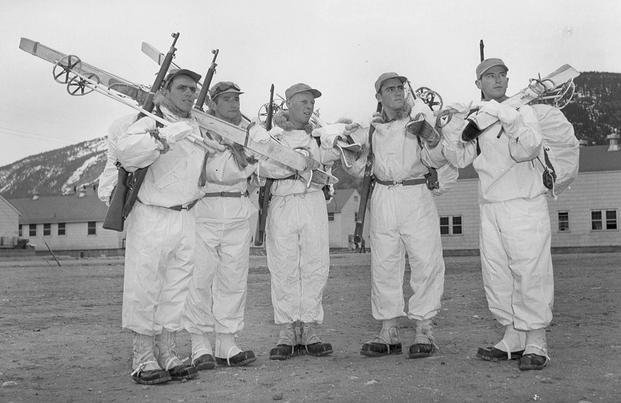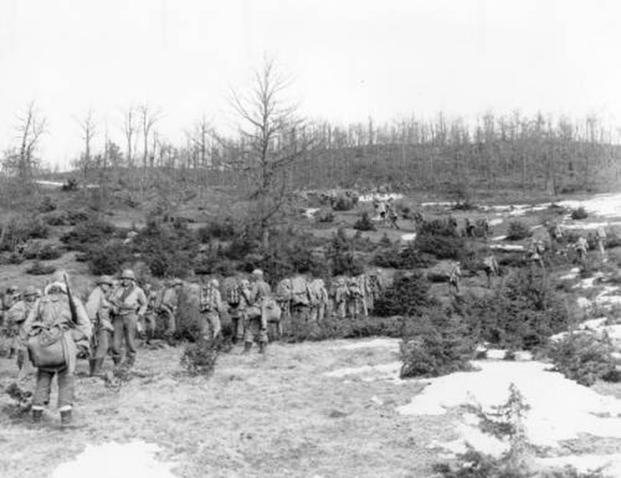At 9,200 feet in the Colorado Rockies, the U.S. Army built Camp Hale in 1942 to train a new kind of soldier. The 10th Mountain Division was created to fight in snow, ice, and high-altitude terrain that had hampered armies for centuries. Its formation was the result of a civilian campaign led by Charles Minot “Minnie” Dole, the founder of the National Ski Patrol, who convinced Army leaders that the United States needed a force capable of operating in extreme cold-weather conditions.
Over the next two years, thousands of men learned to ski, climb, and survive at Hale, developing tactics and equipment that turned into one of the Army’s most influential training programs. When the division deployed to Italy in 1945, its success in the Apennine Mountains proved that Dole’s idea had been right—and its lessons still shape how American troops train for cold-weather warfare today.
The Background
Dole wasn’t a soldier, but he understood mountains better than anyone in Washington. A lifelong skier from Connecticut and founder of the National Ski Patrol, Dole spent the early years of World War II warning that the U.S. Army had no troops trained for winter or alpine combat. His letters to the War Department went unanswered until he wrote directly to Army Chief of Staff Gen. George C. Marshall in 1940, arguing that the nation was unprepared for cold, snow, and altitude as an enemy.
Dole backed his case with examples from Europe. Finland’s ski troops had bloodied Soviet forces in the Winter War, and Germany’s Gebirgsjäger had used mountain skills to seize Norway and Greece. He proposed that the Army use his Ski Patrol as a recruiting network to find athletes, climbers, and woodsmen who already had the physical skills the service lacked.
In late 1941, the Army agreed. Dole was authorized to recruit volunteers through the National Ski Patrol, marking the first and only time a civilian organization directly recruited for the U.S. Army. The result was the activation of the 87th Mountain Infantry Battalion, which became the 10th Light Division (Alpine) — later redesignated the 10th Mountain Division. Dole’s persistence and organization had built an entirely new unit designed from the ground up to fight where no other American force could.

Camp Hale
Construction crews began carving Camp Hale out of Colorado’s Pando Valley in the spring of 1942. The site was chosen for its altitude — 9,200 feet above sea level — and its proximity to steep slopes and unpredictable weather. By that winter, the new Mountain Training Center had turned the remote valley into a self-contained city with more than 1,000 buildings, 245 miles of trails, rifle and artillery ranges, and ski slopes for training. At its peak, more than 15,000 soldiers lived and trained there.

Conditions were intentionally harsh. Recruits skied and snowshoed with 90-pound packs, practiced climbing on frozen cliffs, and built shelters in snowdrifts during exercises. Soldiers woke to find their clothes, boots and socks had frozen to their skin overnight. The altitude and constant cold took a toll. A 1944 divisional report noted that the combination of thin air, smoke from coal stoves, and poor circulation in the valley caused what soldiers called the “Pando hack,” a persistent cough that forced many to seek medical treatment. Frostbite, sprains, and exposure were common.
The main training event came in March 1944 with the “D-Series,” a month-long field exercise designed to simulate sustained mountain warfare. Temperatures dropped to 35 degrees below zero, tents collapsed under snow, and more than a thousand soldiers were evacuated with injuries or frostbite. Despite the hardship, the exercise pointed out weaknesses in clothing, rations, and logistics, leading to major improvements in Army cold-weather gear and mobility techniques. Even mules and donkeys were used to haul heavy equipment and ammunition up the steep mountain cliffs.
Italy
By the time the 10th Mountain Division deployed to Italy in late 1944, the soldiers who had survived Camp Hale’s thin air and bitter cold were among the most physically prepared troops in the Army. Their task was to help break through the German Gothic Line — a series of fortified positions stretching across the northern Apennine Mountains that had stalled Allied progress for months. The terrain was steep, icy, and heavily defended.
In February 1945, the division’s first major operation tested everything it had trained for. The Germans occupied a ridgeline called Riva Ridge overlooking Mount Belvedere, giving them observation and artillery angles over the main Allied approach. Earlier attempts by other units to take Belvedere had failed, but the 10th’s commanders realized the key was first seizing Riva Ridge. On the night of February 18, 1945, soldiers from the 1st Battalion, 86th Mountain Infantry Regiment began climbing the 1,500-foot cliffs in darkness and silence, carrying ropes, weapons, and supplies. By dawn, they had taken the summit and driven off the defenders without alerting nearby German forces.

The next night, the rest of the division attacked Mount Belvedere itself, advancing under heavy fire up slopes that required ropes and ladders to overcome. Over the next five days, the 10th captured a series of peaks — Belvedere, Gorgolesco, and Della Torraccia — opening the way for Allied forces to advance into the Po Valley. The operation cost more than 900 casualties but broke the stalemate that had held since the previous fall. Fifth Army commander Lt. Gen. Lucian Truscott praised the unit’s performance as “an inspiration to the entire Fifth Army.”
In the weeks that followed, the 10th pushed north through the Po Valley and into the foothills of the Alps. The fighting ended with both tragedy and victory. On April 30, 1945, a DUKW carrying 10th Mountain soldiers across Lake Garda capsized in rough water, killing 25 men — one of the division’s worst single losses of the war. The same day, Col. William O. Darby, founder of the Army Rangers and the division’s assistant commander, was killed by artillery fire near Torbole. Within days, German forces in Italy surrendered.
The 10th’s short but intense combat experience validated the training and doctrine built at Camp Hale. Its soldiers proved that specialized units trained for mountain and winter warfare could operate effectively in terrain that blocked conventional forces. Many of the division’s field lessons — from rope movement and mule supply to night climbing and casualty evacuation in snow — were later incorporated into postwar Army manuals and remain part of cold-weather training at Fort Drum and the Army Mountain Warfare School today.
Why It Still Matters
After the war, the Army integrated the division’s field experience into official training materials and equipment programs. Tests on winter rations, layered clothing, and lightweight shelters produced designs later used in Korea and Alaska. Many of the division’s officers went on to help establish specialized courses, including the Army’s Mountain Warfare School in Vermont and the Cold Weather Leader Course in Alaska, ensuring that the tactics forged in the Rockies and refined in Italy remained part of every generation of soldier training for cold climates.
The 10th’s influence also reached beyond the military. Hundreds of its veterans became leaders in postwar outdoor recreation, founding ski resorts, designing gear, and promoting mountain conservation. The same knowledge that carried them up the Apennines helped shape America’s postwar connection to skiing and wilderness sports. When Camp Hale was designated a National Monument in 2022, it honored not only a training site but also the lasting impact of a civilian’s idea, which shaped the military’s cold-weather doctrine.
Eighty years after its creation, the 10th Mountain Division continues to train soldiers to operate in snow, high altitudes, and extreme cold. Using new technologies and advancements, from modern rucksacks and cold-weather MREs, as well as traditional mountaineering equipment like skis and ropes, the division still uses many of the lessons learned at Hale to fight in the world’s harshest terrain.
















